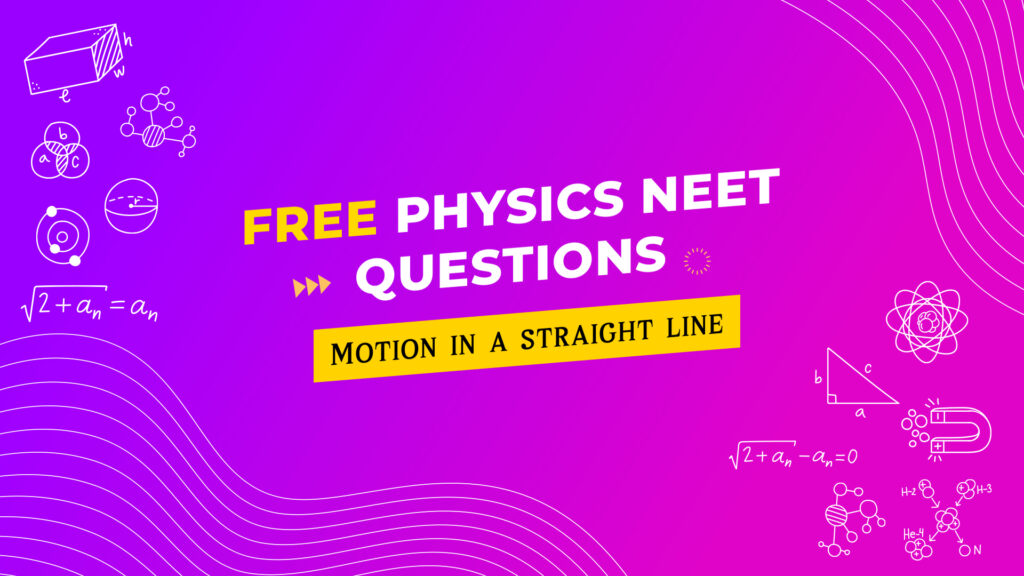Physics, renowned for its intricate theories and complex numerical applications, often becomes a formidable obstacle for NEET aspirants, leading many to shy away from it. The challenges associated with the subject are multifaceted, ranging from the abstract nature of its concepts to the rigorous problem-solving techniques it demands. Students often find it difficult to grasp fundamental principles and struggle to visualize their practical implications.
Among the various topics that pose difficulties, Motion in a Straight Line is an important chapter that many NEET entrants find particularly daunting. It delves into the fundamental principles of kinematics, requiring aspirants to comprehend the nuances of velocity, speed, acceleration, and displacement. However, the conceptual nature of these concepts, coupled with the need to solve complex equations, can make it an uphill battle for aspiring medical students.
Nevertheless, you don’t need to worry as a sure shot way to improve your precision and pace is by practicing NEET Physics Questions. Trying questions regularly will not only reinforce your conceptual knowledge but also enhance your problem-solving skills. In this article, we are providing you with 10 free sample NEET questions from the Motion in a Straight Line chapter in Physics. These would expose you to different scenarios and applications of the notions involved in the chapter and also aid to get a deeper understanding of how velocity, acceleration, and displacement relate to practical situations.
Q1. A train covers the first half of the distance between two stations at a speed of 40km/h and the other half at 60 km/h. Then its average speed is:
A. 50 km/h
B. 48 km/h
C. 52 km/h
D. 100 km/h
Click here for answer and detailed explanation.
Q2. A drunkard is walking along a straight road. He takes 5 steps forward and 3 steps backward and so on. Each step is 1m long and takes 1s. There is a pit on the road 11m away from the starting point. The drunkard will fall into the pit after
A. 21 s
B. 29 s
C. 31 s
D. 37 s
Click here for answer and detailed explanation.
Q3. Assertion: Doubling the initial velocity, the stopping distance of moving object increases by a factor of 4 (for the same deceleration).
Reason: Stopping distance is proportional to the square of the initial velocity.
A. If both assertion and reason are true and reason is the correct explanation of assertion.
B. If both assertion and reason are true but reason is not the correct explanation of assertion.
C. If assertion is true but reason is false.
D. If both assertion and reason are false.
Click here for answer and detailed explanation.
Q4. Assertion: A particle may be momentarily at rest and yet have non-zero acceleration.
Reason: The zero velocity of a particle at any instant does not necessarily imply zero acceleration at that instant.
A. If both assertion and reason are true and reason is the correct explanation of assertion.
B. If both assertion and reason are true but reason is not the correct explanation of assertion.
C. If assertion is true but reason is false.
D. If both assertion and reason are false.
Click here for answer and detailed explanation.
Q5. A body falls from a height h=200 m. The ratio of distance travelled in each 2s, during t=0 to t=6s of the journey is:
A. 1:4:9
B. 1:2:4
C. 1:3:5
D. 1:2:3
Click here for answer and detailed explanation.
Q6. A body falls from height h. The velocity-distance (v−s) graph is:




Click here for answer and detailed explanation.
Q7. If displacement of a particle is zero, the distance covered:
A. must be zero.
B. may or may not be zero.
C. cannot be zero.
D. depends upon the particle.
Click here for answer and detailed explanation.
Q8. The location of a particle is changed. What can we say about the displacement and distance covered by the particle?
A. Both cannot be zero
B. One of the two may be zero
C. Both must be zero
D. If one is positive, the other is negative and vice-versa
Click here for answer and detailed explanation.
Q9. The magnitude of the displacement is equal to the distance covered in a given interval of time if the particle:
A. moves with constant acceleration
B. moves with constant speed
C. moves with constant velocity
D. none of the above
Click here for answer and detailed explanation.
Q10. A ball is released from the top of a tower of height h metres. It takes T seconds to reach the ground. What is the position of the ball in T/3 seconds?
A. h/9 metres from the ground
B. 7h/9 metres from the ground
C. 8h/9 metres from the ground
D. 17h/18 metres from the ground
Click here for answer and detailed explanation.
Darwin offers the most extensive question bank for the NEET exam, providing a comprehensive range of questions from every topic. With 18,000+ Physics MCQs available, you can rest assured of coming across different types of questions asked in NEET from every chapter. Dedicate maximum time to solving MCQs to strengthen your knowledge and score well in the NEET exam.
